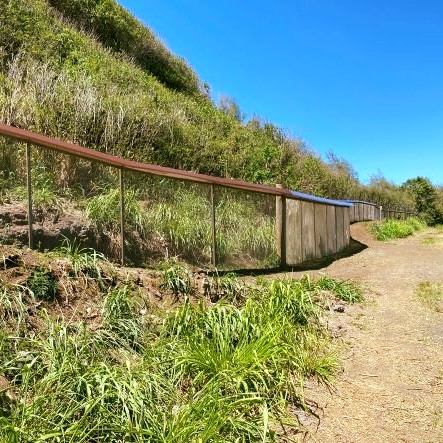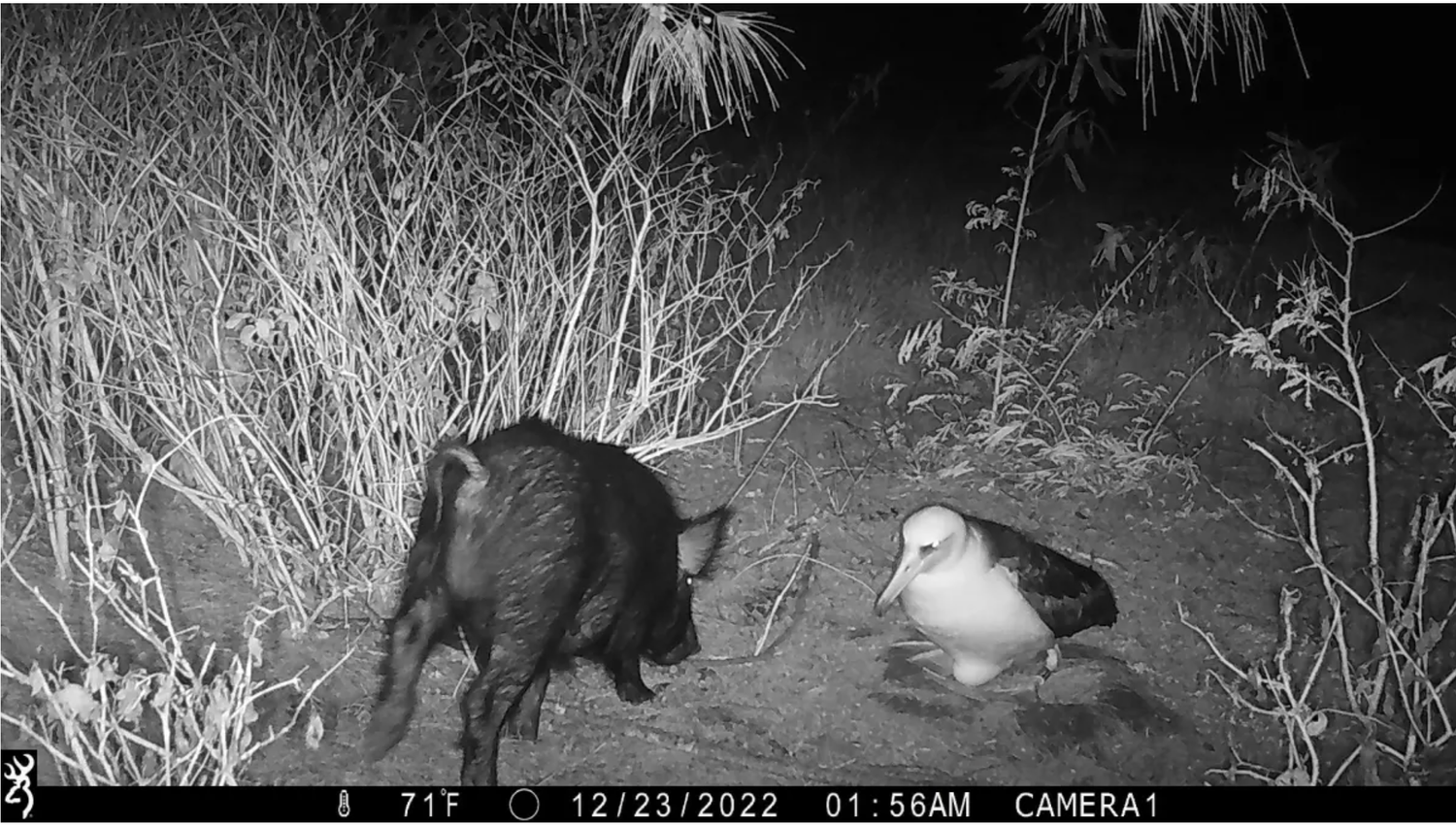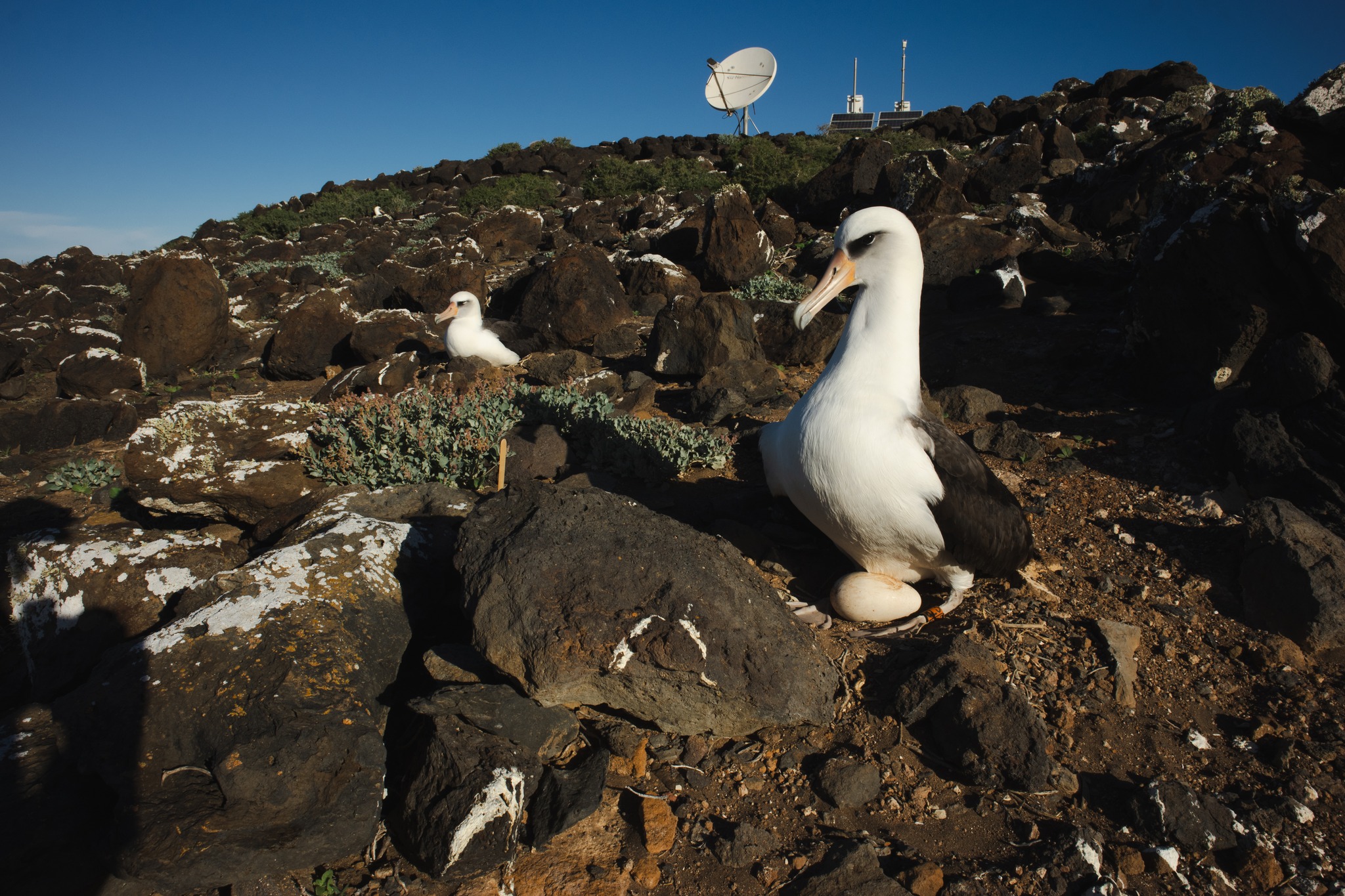
The new predator-proof fence in the Kīlauea Point National Wildlife Refuge, photograph by US Fish & Wildlife Service
Laysan Albatrosses Phoebastria immutabilis are breeding again in the North Pacific. The vast majority breeds on the low-lying atolls of the North-Western Hawaiian Islands where they at risk to flooding caused by storms, considered to be more of an issue with climate change-induced sea level rise. However, on the inhabited high Hawaiian islands of Kauai and Oahu the few relatively small colonies are safe from sea level rise, acting as a level of insurance for the Near Threatened species. News is in on the fortunes of Laysan Albatrosses in two of these colonies that are protected by predator-proof fences.
Kauai
The record number of 153 pairs of Laysan Albatrosses breeding in the 2023/24 season – 20 more than in the previous season - in the Kīlauea Point National Wildlife Refuge on the Hawaiian island of Kauai will have an enhanced chance of a high breeding success. This is due to the recent completion of a 3.4-km-long predator-roof fence surrounding 68 ha that will keep feral cats and pigs, stray dogs and rodents down to, it is stated, the size of a baby House Mouse, away from the birds. In the 2022/23 season pigs gained entry and destroyed nearly 70 albatross nests, prior to completion of the fence (click here). Any remaining predators caught within the fenced area are now being removed.
UPDATE: The total occupied nest count was 157. 131 eggs have survived as hatching time approaches. The "natural decline is due to infertile eggs, abandonment of nests, and predation". Information from the Facebook page of the Kilauea Point National Wildlife Refuge.

A feral pig approaches an incubating Laysan Albatross at night in the Kīlauea Point National Wildlife Refuge on 23 December 2022, trail camera photograph by Pacific Rim Conservation
More information comes from USFWS Volunteer Louise Barnfield in the December issue in Wild Times, newsletter of the Kilauea Point Natural History Association.
“Last week, Kīlauea Point NWR participated in the annual mōlī (Laysan albatross) egg swap with a team of biologists from the Pacific Missile Range Facility (PMRF), located on the west side of Kauaʻi. Due to the potential for airstrikes, mōlī in the PMRF colony are a risk to aircraft and to themselves. Therefore, their biologists are employing multiple approaches as they work to reduce the size of their colony. For this year’s egg swap, 23 fertile eggs were removed from the PMRF mōlī colony and transported to Kīlauea Point NWR where they replaced 23 non-viable eggs within the Refuge’s two colonies. Through a process called “candling”, biologists can identify eggs that are non-viable – either because they were not fertilized or are damaged. They can then “swap” the eggs and our adoptive nesters will then get to raise ex-PMRF chicks, which will imprint upon the safe colonies at Kīlauea Point NWR and eventually return to our hatching sites, rather than PMRF.”

A Laysan Albatross incubates within the Kaena Point Natural Area Reserve, photograph by Pacific Rim Conservation
In complete contrast, the construction of a wrought iron security fence elsewhere on Kauai has led to the death by entanglement of a colour-banded (white V389) Laysan Albatross, known as Hoʻokipa (click here).
 "Hoʻokipa, the first Laysan albatross to return to nesting within an ecological restoration area makai of the Turtle Bay golf course, died last month after getting stuck in an iron fence near her new nest at Marconi Point"
"Hoʻokipa, the first Laysan albatross to return to nesting within an ecological restoration area makai of the Turtle Bay golf course, died last month after getting stuck in an iron fence near her new nest at Marconi Point"
Oahu
Over on the Hawaiian island of Oahu, Laysan Albatrosses are also doing well behind a predator-proof fence around the Kaena Point Natural Area Reserve. The environmental NGO, Pacific Rim Conservation reports on its Facebook page that there are “106 mōlī nests and counting at Ka'ena Point- a new record! 2023 marks the 20th year that we have monitored Laysan Albatrosses on O'ahu”. Laysan Albatrosses also breed within the translocation site protected by a predator-proof fence in Oahu’s James Campbell National Wildlife Refuge. A more recent Facebook post by Pacific Rim Conservation has a record of 156 occupied nests for Kaena Point and the nearby Kuaokala Game Management Area combined.
 A colour-banded Laysan Albatross rises on its egg on Isla Guadalupe, December 2023, photograph by Felix Jimenez Roja, GECI
A colour-banded Laysan Albatross rises on its egg on Isla Guadalupe, December 2023, photograph by Felix Jimenez Roja, GECI
FOOTNOTE. Across the Pacific in Mexico, Isla Guadalupe is also having a record year, according to the Mexican NGO Conservación de Islas (GECI) on its Facebook page: "The end of the year is near and Guadalupe Island is painted white thanks to the arrival of the Laysan Albatross. So far we have registered over 400 nests on the main island breaking the historic record on the island". In 2009 a census yielded 457 pairs - but this seemed to include the nearby Islote Zapato and Islote Negro, with perhaps 50 pairs each.
John Cooper, Emeritus Information Officer, Agreement on the Conservation of Albatrosses and Petrels, 18 January 2024, updated 21 January 2024

 English
English  Français
Français  Español
Español